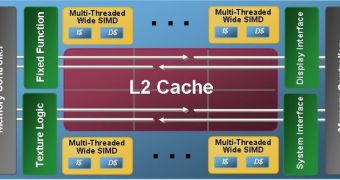Intel's many-core graphics chip Larrabee was designed to compete with NVIDIA's and ATI's products. The graphics processor's launch has been delayed repeatedly, even though it was supposedly going to overshadow NVIDIA's CUDA and even said to have reached the performance level of the GeForce GTX 285 back in June. Each time the product was postponed, however, the Santa Clara-based chip maker was vague about the supposed motives for the delays, and this time is no exception.
The Larrabee is a Pentium-based 32-core chip with parallel x86 architecture that was supposedly going to best NVIDIA's and ATI's GPUs through using "new languages" in the computing process. The chip maker reportedly planned to employ preferential pricing in order to carve its way into the graphics market currently controlled by AMD and NVIDIA, but on Friday, the leading CPU maker said that the Larrabee would not be launched as a standalone product, without offering a clear explanation.
"Larrabee silicon and software development are behind where we hoped to be at this point in the project," Intel spokesperson Nick Knupffer told CNET.com. "As a result, our first Larrabee product will not be launched as a standalone discrete graphics product."
Intel said it would be launching a kit that would enable third-party and internal developers to build on the platform. Without offering any additional details, the Larrabee was simply 'revealed' to be programmed for release "next year." The chip was already demonstrated in September when it was shown to have individual cores especially adept at intercommunication and running the vector math often employed in 3D graphics.
One can only speculate what Intel's reasons could be, but they may be related to possible bugs that may appear in early samples or the fact that AMD is already selling 3 teraflops-capable products, whereas the Larrabee only ran at 1 teraflop during the SC09. Intel may have not been able to reach the intended performance capabilities and may be considering the possibility for the Larrabee to be overshadowed by the upcoming products from NVIDIA and ATI, especially the Fermi architecture.

 14 DAY TRIAL //
14 DAY TRIAL //